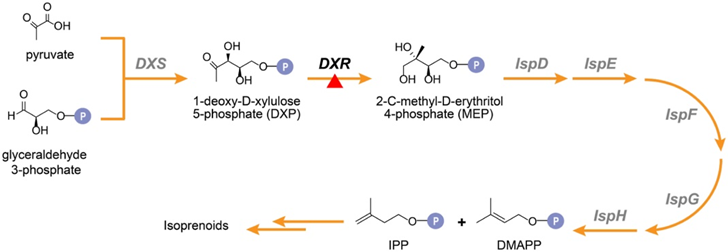Malaria and tuberculosis, caused by Plasmodium spp. and Mycobacterium tuberculosis respectively, continue to pose global health challenges with an estimated 429,000 deaths annually. While efforts have been underway to develop drugs targeting the causative agents behind these diseases, the rise of drug resistance strains of these pathogens has limited effective therapies and continues to challenge those that do currently work. Plasmodium and M. tuberculosis rely on isoprenoid biosynthesis through the methylerythritol phosphate (MEP) pathway (as shown in Figure 1A) for survival — a pathway absent in humans—making it an ideal target for therapeutic intervention.
To overcome the challenge of drug resistance, Dr. Cynthia Dowd, a professor at George Washington University, has synthesized and characterized novel compounds known as "MEPicides" that inhibit the MEP pathway by targeting a key enzyme, 1-deoxy-D-xylulose-5-phosphate reductoisomerase (DXR). These MEPicides are structurally unique analogs of FR90098, a naturally occurring but clinically ineffective compound. By binding effectively to DXR, select MEPicides such as Compound A and Compound B in Figure 1B demonstrate enhanced potency against Plasmodium and hold potential for combating resistant strains in both malaria and tuberculosis.
A

B

Figure 1: Targeting of DXR by MEPicides in the canonical MEP pathway. A) Schematic of MEP pathway in P. Falciparum; B) Mycobacterium tuberculosis whole cell minimum inhibitory concentration (MIC) data (μM) for current antimalarial drug fosmidomycin (FSM), compared to Compound A and Compound B (specific MEPicides).
Advantages:
Applications:
-
Inhibition of 1-deoxy-D-xylulose-5-phosphate reductor-isomerase
-
Development of treatment for tuberculosis, malaria, and other infections
Publications:
Inhibition of DXR in the MEP pathway with lipophilic N-alkoxyaryl FR900098 analogs. Darean Bague, Ruiqin Wang, Dana Hodge, Marwa O Mikati, Jose S Roma, Helena I Boshoff, Allyson L Dailey, Misgina Girma, Robin D Couch, Audrey R Odom John, Cynthia S Dow. RSC Med Chem. 2024 May 22;15(7):2422-2439